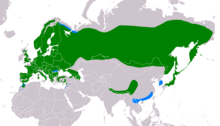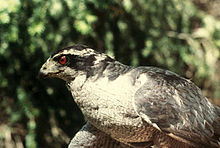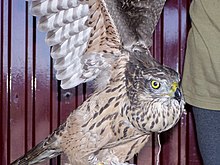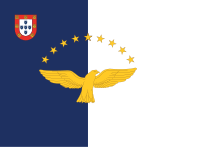hawk
| hawk | ||||||||||
|---|---|---|---|---|---|---|---|---|---|---|

Goshawk ( Accipiter g. Gentilis ), adult male |
||||||||||
| Systematics | ||||||||||
|
||||||||||
| Scientific name | ||||||||||
| Accipiter gentilis | ||||||||||
| ( Linnaeus , 1758) |
The goshawk ( Accipiter gentilis ) is a bird of prey that belongs to the hawk-like family (Accipitridae). The range of the species includes the arctic to subtropical zones of the Holarctic . Goshawks feed mainly on small to medium-sized birds and mammals up to a weight of about 1.0 kg. The species is not endangered.
The German Nature Conservation Association and the State Association for Bird Protection in Bavaria have chosen the hawk as " Bird of the Year 2015" in Germany.
description
Hawks are medium-sized birds of prey; the body length is 46–63 cm, the wingspan 89–122 cm. The weight is between 0.52 kg for the smallest males and 2.2 kg for the largest females. The large range is due to the significant increase in size and weight from southwest to northeast and the strong reverse sex dimorphism in terms of body size. The female is about as large as a Buzzard , the male ( "Terzel") is significantly smaller. In eastern Germany, for example, adult males weighed an average of 724 g, adult females 1133 g, the wing length of adult males from the same area averaged 314 mm, and females 353 mm.
The wings are relatively short, broad and rounded at their tips, the tail is relatively long. These features are typical of the predominantly forest-dwelling representatives of the genus Accipiter ; they do not allow extreme flight speeds, but high maneuverability in confined spaces. Fully grown (adult) hawks are slate gray-brown on the upper side, white on the underside with dark brown transverse bands. Young birds are brownish on top until the first moult , on the underside light yellow, yellow, beige, orange or salmon-colored with a vertical drop or line drawing.
The large plumage shows in all clothes a clear banding on a white to beige-brown background, in young birds on a yellowish background. The legs are yellow, as is the wax skin of the beak. The iris of the eyes is light yellow in young birds and turns dark yellow, orange or cherry red with age. But this depends on the individual, so a six-year-old goshawk can have darker eyes than a twelve-year-old.
The plumage is very similar in the sexes, adult males are slightly darker and more blue-gray on the upper side than adult females and show a slightly more contrasting head drawing.
Vocalizations
Hawks call almost exclusively near the nest. The most frequent call is a sharp, often ranked "gik, gik, gik" ("gickern"), which is generally used when aroused, e.g. B. is expressed in case of disturbances and can be heard particularly frequently during courtship from January to March. These calls can be heard several hundred meters away in calm weather. The contact call between the breeding partners is a short, not very noticeable “gjak”, which, for example, precedes the handover of the prey or the replacement of the brood. If the partner does not react immediately, there is a soft “giggle” or, like the young bird, a drawn out “hiiäh” call. When copulating, both partners shout a relatively high, ranked "confused, confused, confused". Also very noticeable are the loud begging calls of the young birds after they leave, which sound like “hiiiiääh” or “klijäh” (“lhnen”) and are also repeated frequently.
distribution and habitat
Several subspecies of hawks inhabit the coniferous forests of the taiga and the mountains (the so-called boreomontane forests) as well as the forests of the temperate and Mediterranean zones of the entire Palearctic.In North America, the occurrence is predominantly limited to the boreomontane forests. In the western Palearctic, the northern limit of distribution coincides with the northern limit of the boreal coniferous forests (taiga) in Scandinavia , Finland and Russia , in the south the distribution extends in the west to North Africa, further east to Greece , Asia Minor and northern Iran .
The habitat requirements that are absolutely necessary for the habitat to occur in Europe are limited to trees that are suitable for the nest (more than 60 years old) and a sufficient supply of medium-sized birds and mammals. Within their European range, hawks therefore colonize forests of all types and sizes. The goshawk occurs here in large, closed forest areas as well as in the open cultural landscape, if there are at least individual field trees.
For reasons that are so far unclear, the occurrence of the hawk in North America is limited to near-natural forests, where it is considered to be a stenöker inhabitant of primeval forests, comparable to the status of the capercaillie in Central Europe.
Urban populations
The goshawk is currently one of at least 20 species of birds of prey worldwide that also live in or around cities (urban habitats ). The colonization of urban habitats by hawks is a relatively new phenomenon, until the late 1960s there were only sporadic observations. The urban populations have so far been restricted to Europe; such populations are currently known from Berlin , Cologne , Saarbrücken , Hamburg and Kiev .
Subspecies
The delimitation of the subspecies occurring in the Palearctic is complex and is discussed intensively in science. The transitions between the subspecies are mostly fluid. Depending on the author, the number and geographical delimitation of the subspecies often differ considerably. The following presentation is essentially based on the Handbook of Birds in Central Europe (Volume 4, 1989).
A total of ten subspecies are currently recognized, three of them in North America:
- A. g. gentilis ( Linnaeus , 1758): Northern and Central Europe, south to the Pyrenees , southern Alps and Carpathians , east to central Russia
- A. g. marginatus ( Piller & Mitterpacher , 1783): South adjoining nominate form , Spain and Morocco to the Caucasus and Elburs ; darker and slightly smaller than nominate shape
- A. g. arrigonii ( Kleinschmidt, O , 1903): Corsica and Sardinia ; even darker and smaller than A. g. marginatus
- A. g. buteoides ( Menzbier , 1882): North-east adjoining the nominate form, from northern Sweden, but according to some authors also only from the Kola peninsula to eastern to western and central Siberia to about the Lena , south to the edge of the taiga zone ; larger and, especially in youth clothing, significantly lighter than the nominate shape
- A. g. albidus ( Menzbier , 1882): Northeastern Siberia to Kamchatka ; even greater than A. g. buteoides , with a gray and a very conspicuous white morph
- A. g. schvedowi ( Menzbier , 1882): South of A. g. buteoides and A. g. albidus in the forest steppe zone and in the temperate deciduous forests of East Asia up to and including Hokkaidō ; Color and size about as A. g. marginatus
- A. g. fujiyamae ( Swann & Hartert , 1923): On the main Japanese island of Honshū , very dark, probably the smallest subspecies
- A. g. atricapillus ( Wilson, A , 1812): Most of North America; blue-gray upper side, very high-contrast head pattern, ad. Individuals with finely dashed and speckled underside and carmine-red iris. Species status for this and the following two subspecies is discussed (then A. atricapillus )
- A. g. laingi ( Taverner , 1940): Vancouver Island and Haida Gwaii off the coast of the Canadian province of British Columbia ; darker than A. g. atricapillus
- A. g. apache van Rossem , 1938: Montane areas in the border area Mexico / USA ; lighter than A. g. atricapillus
Overall, in accordance with Bergmann's rule, a significant increase in size and weight of the hawk from southwest to northeast can be observed in the Palearctic .
Hunting style and diet
Goshawks hunt their prey mainly from the ground-level flight or from the hide in a short, fast and very agile pursuit flight directly on the ground or in the ground-level airspace. Natural structures such as hedges, trees, but also houses in the settlement area are very cleverly used for a covered approach. More rarely, birds are hunted down from high circles in the open air space or near the ground. In spring and summer, hawks systematically search for nests in higher vegetation and on trees and thus prey on numerous young birds. In the case of smaller bird species, the entire nest and its contents are often grasped, the empty nests are then often found at the plucking places. Goshawks have also been observed hunting on foot, for example moles are caught, and brooding mallards are also struck on densely vegetated islands .
The prey is grabbed with the feet (fangs) and killed, the claws of the very powerful first and second toes are drilled into the prey until it stops moving. In conjunction with the relatively long legs, this killing method enables the hawk to use comparatively large and well-fortified prey.
Goshawks feed almost exclusively on small to medium-sized birds and mammals in their entire range . Rather seldom, e.g. B. in winter, they also go to carrion. Reptiles are also regularly captured in the south of the range . Amphibians , fish and invertebrates are very rarely used as food by hawks. The weight of the prey animals is between 5 g and 3.5 kg, in Central Europe the prey spectrum in birds ranges from golden cockerels to geese , in mammals from mice to adult rabbits and adolescent hares . Small to medium-sized birds of prey and owls are regularly captured, in Central Europe mainly sparrowhawks and kestrels , but also buzzards and kites , nestling or even fledgling, ospreys and spotted eagles are also struck. Mostly, however, animals with a body mass of 0.05–1.0 kg are used, in Central Europe mainly pigeons , thrushes , corvids and chicken birds . In the taiga of Scandinavia and Russia dominate in food grouse , next play wood pigeons , crows and squirrels play an important role.
Use of space
The size of the action area depends, among other things, on the sex, age, status (paired, unpaired) of the individual examined, as well as the season and the local food supply. In Hamburg , males flew an average of 8.6 km 2 during the breeding season , in Schleswig-Holstein 13–55 km 2 , in Arizona / USA 18 km 2 and in Alaska / USA 39.8 km 2 .
Outside the breeding season, male territories in Schleswig-Holstein comprised 5–64 km 2 , and females in the same area 16–59 km 2 . In central Sweden , males flew an average of 51 km 2 (18–80 km 2 ) in winter , females an average of 62 km 2 (32–92 km 2 ). In northern Finland, finally, the winter home ranges of adult males were on average 88 km 2 (79 to 97 km 2 ), of juvenile males 110 km 2 (50–170 km 2 ), of adult females 69 km 2 ( 48–94 km 2 ), of juvenile females 67 km 2 (31–103 km 2 ). The overview shows the clear increase in the size of the territory with increasing latitude, this increase is certainly due to the greatly decreasing prey density towards the north, especially in winter.
Reproduction
Territorial behavior
Hawks are monogamous and strictly territorial. The area is marked by frequent "gickern" (cf. sounds) and by sightseeing flights. During these sightseeing flights, the wings are slowly flapped low down and up again in a straight flight. If other conspecifics intrude into the area, an attempt is first made to drive away the intruder by shouting, then by approaching and shouting further. In contrast to other birds of prey, direct physical contact attacks on hawks in the context of territorial disputes are apparently only carried out as a last resort. Presumably this is due to the fact that such a confrontation is associated with considerable risk for both parties because of the feet and claws that specialize in the rapid killing of relatively large vertebrates.
Breeding biology
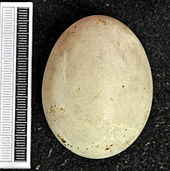
Hawks build large, voluminous nests (clumps) exclusively on trees. The minimum age of the trees used for nesting is around 60 years. Within larger forest areas, the hawk prefers old wood stocks with almost 100% crown closure, these stocks are often very dark in summer near the ground due to the low incidence of light. The dominant trees of a stand are usually used for building the nest, preferably on a small aisle or on a path. The clumps are often used for years, usually alternating with other clusters within the breeding area.
At the beginning of the courtship , the nest chosen for brood is built up with green branches, this greening is continued into the late nestling age. Goshawks make an annual brood, in Central Europe the eggs are laid mostly in mid-March to mid-April, the clutch size is one to five, usually two to four eggs. The eggs are unmarked and pale green to pale blue. The young birds hatch after a breeding season of 37 to 39 days. Compared to other species of birds of prey (e.g. the real eagles of the genus Aquila , buzzards or harriers ), nest-young hawks are very peaceful with one another, so losses due to sibling deaths are very rare. The young birds can fledge at around 40–45 days. They leave their parents' territory three to six weeks after leaving .
hikes
The species is a resident bird in Central Europe , young birds show an undirected dispersion . The distances to the place of birth are usually less than 30 km in Central Europe.
Existence and endangerment
Since hawks often prey on species used for hunting , such as the pheasant as well as domestic fowl and carrier pigeons, they were pursued by hunters and small animal breeders in large parts of their range. Within Europe, the species was exterminated in Great Britain (last broods 1893 and 1938–1951, repopulation from 1965, in 1991 230 pairs were counted there again), in the other countries the populations were drastically reduced by the end of the 19th century , and complete extinction took place but in no other country. In contrast to other bird of prey species (especially white-tailed eagle ( Haliaeetus albicilla ), sparrowhawk ( Accipiter nisus ) and peregrine falcon ( Falco peregrinus )), the goshawk was hardly affected by the Europe-wide use of DDT until the early 1970s . After the hawk was placed under protection from around the beginning of the 1970s, there was a significant increase in populations in many parts of Europe and Germany, for example in the Netherlands , North Rhine-Westphalia, as well as in Brandenburg and Berlin . The number of breeding pairs in Germany is estimated to be 11,500–16,500 in 2014 (including around 100 in the city of Berlin), for Austria in 2000 to 2000–2300 and for Switzerland for 1995 to 1400–1600.
Man and hawk
Since the hawk also prey on domestic fowl, a number of superstitious practices have been established over the centuries to keep them away from pigeons and chickens . These are or were different from region to region. In the Upper Palatinate, for example, the tearing out of three hawk feathers, which were then brought to another municipality, was supposed to protect one's own poultry from attack.
In Westphalia, on the other hand, it should help if you put a bare kettle next to the young poultry.
Other rituals are linked to the Easter holidays : anyone who let the chickens through a wooden hoop on Good Friday also protected them from the hawk. Another traditional ritual is more complicated: Something of all the food on the Easter table had to be sprinkled around the courtyard, and the following saying had to be said:
- Hawk, hawk
- here I give you an Easter lamb
- don't eat me chickens
Similar to what has been passed down for owls , a hunted hawk, which was hung on the stable door, was supposed to protect the yard from witches and keep other birds of prey away.
The ancestral castle of the Habsburgs , the Habsburg in the Swiss canton of Aargau , is said to have been named Habichtsburg by its builder, according to legend , when a hawk settled on the castle walls. More likely, however, is a name based on the old German word "hab" / "haw" as a term for "river crossing".
The flag of the Azores flies a hawk. He points out that the name of the islands is derived from its Portuguese name Açor . However, this is due to an error. The sailors who gave the islands their name found common buzzards ( Buteo buteo ) on the islands. There are no hawks in the Azores.
literature
- RG Bijlsma: Ecological Atlas van de Nederlandse Roofvogels. Schuyt & Co, Haarlem 1993, ISBN 90-6097-348-8 .
- Stanley Cramp , KEL Simmons: Handbook of the Birds of Europe the Middle East and North Africa - The Birds of the Western Palearctic. Volume 2. Oxford University Press, Oxford / New York 1980.
- Urs N. Glutz von Blotzheim , KM Bauer , E. Bezzel: Handbook of the birds of Central Europe. Volume 4, 2nd edition. AULA-Verlag, Wiesbaden 1989.
- D. Forsman: The Raptors of Europe and the Middle East - A Handbook of Field Identification. T. & AD Poyser, London 1999.
- EJM Hagemeijer, MJ Blair (Eds.): The EBCC Atlas of European Breeding Birds: Their Distribution and Abundance. T. & AD Poyser, London 1997.
- V. Looft, G. Busche: Bird world of Schleswig-Holstein. Volume 2: Birds of Prey. Karl Wachholtz Verlag, Neumünster 1981.
- L. Artmann, N. Kennner, C. Neumann, S. Schlegl: The Habicht - From the forest hunter to the city dweller. Oertel + Spörer Verlag, Reutlingen 2014.
- Carl von Linné: Systema Naturae per Regna Tria Naturae, Secundum Classes, Ordines, Genera, Species, Cum Characteribus, Differentiis, Synonymis, Locis . 10th edition. tape 1 . Imprensis Direct Laurentii Salvii, Stockholm 1758 ( online [accessed April 12, 2015]).
- Adriaan Joseph van Rossem: A Mexican Race of the Goshawk (Accipter gentilis (Linnaeus)) . In: Proceedings of the Biological Society of Washington . tape 51 , 1938, p. 99-100 ( online [accessed April 12, 2015]).
- Alexander Wilson: American Ornithology or, the Natural History of the Birds of the United States: Illustrated with Plates Engraved and Colored from Original Drawings taken from Nature . tape 6 . Bradford and Inskeep, Philadelphia 1812 ( online [accessed April 12, 2015]).
- Otto Kleinschmidt: Astur gentilis arrigonii form.nov . In: Ornithological monthly reports . tape 11 , no. 10 , 1903, pp. 152–153 ( online [accessed April 13, 2015]).
- Harry Kirke Swann, Ernst Hartert: Mr. H. Kirke Swann exhibited a new Goshawk from Japan on behalf of Dr. Hartert and himself, and made the following remarks . In: Bulletin of the British Ornithologists' Club . tape 43 , no. 280 , 1923, pp. 170 ( online [accessed April 13, 2015]).
- Percy Algernon Taverner: Variation in the American Goshawk . In: The Condor . tape 42 , no. 3 , 1940, p. 157–160 (English, online [PDF; 264 kB ; accessed on April 13, 2015]).
- Matthias Piller, Ludwig Mitterpacher: Iter per Poseganam Sclavoniae provinciam, mensibus Junio, et Julio anno 1782, susceptum a Mathia Piller et Ludovico Mitterpacher . Typis Regiae Universitatis, prostat apud JM Weingand et JG Köpf, Budapest 1783.
- Mikhail Alexandrovich Menzbier: Орнитологическая география Европейской России . tape 2 . Uchenia Zapiski Imperatorskovo Moskovskii Univ. Otdel Estestvennoistoricheskii, Moscow 1882.
- Helen Macdonald : H is for Hawk. 2014. (German: H for Habicht . 2015, ISBN 978-3-7934-2298-3 )
Web links
- Accipiter gentilis in the endangered Red List species the IUCN 2008. Posted by: BirdLife International . Retrieved October 13, 2008.
- Videos, photos and sound recordings on Accipiter gentilis in the Internet Bird Collection
- J. Blasco-Zumeta, G.-M. Heinze, Northern Goshawk (PDF 5.4 MB)
- Feathers of the hawk
Individual evidence
- ↑ The Habicht is Bird of the Year 2015. Naturschutzbund Deutschland (NABU), October 17, 2014, accessed on December 7, 2014 .
- ↑ Udo Bährmann: About the variation of the hawk . In: Zool. Dep. Mus. Tierk. Dresden. 28; 1965, pp. 65-94; there further dimensions.
- ↑ Voice example
- ^ Carl von Linné, p. 89.
- ↑ Matthias Piller et al., P. 28.
- ↑ Otto Kleinschmidt, p. 152.
- ↑ Michail Alexandrowitsch Menzbier, p. 440.
- ↑ Michail Alexandrowitsch Menzbier, p. 438.
- ↑ Michail Alexandrowitsch Menzbier, p. 439.
- ↑ Harry Kirke Swann et al., P. 170.
- ↑ Alexander Wilson, p. 80, plate 52, figure 3.
- ↑ Percy Algernon Taverner, p. 160.
- ^ Adriaan Joseph van Rossem, p. 99.
- ↑ C. Rutz: Space-temporal habitat use of the goshawk - Accipiter gentilis - in an urban habitat . Diploma thesis . Univ. Hamburg 2001, p. 22 ff.
- ↑ a b F. Ziesemer: Studies on the influence of the hawk on populations of its prey animals . In: Contribution z. Wildlife biology. 2; 1983, ISBN 3-88847-008-0 .
- ↑ DJ Bright-Smith, RW Mannan: Habitat use by breeding male Northern Goshawks in northern Arizona. In: Stud. Avian Biol. 16; 1994, pp. 58-65 cit. in: Christian Rutz: Space-temporal habitat use of the hawk - Accipiter gentilis - in an urban habitat. Diploma thesis. Univ. Hamburg 2001, p. 28.
- ↑ K. Titus, CJ Flatten, RE Lowell: Northern Goshawk ecology and habitat relationships on the Tongass National Forest . In: Rep. Prepared for the For. Serv., Alaska Dept. of Fish and Game, Div. of Wildl. Conser. Juneau, Alaska. Quotation in: Christian Rutz: Space-temporal habitat use of the hawk - Accipiter gentilis - in an urban habitat . Diploma thesis. Univ. Hamburg 2001, p. 28.
- ^ P. Widén: The hunting habits of Goshawks Accipiter gentilis in boreal forests of central Sweden. In: Ibis. 131; 1989, pp. 205-213.
- ^ R. Tornberg, A. Colpaert: Survival, ranging, habitat choice and diet of the Northern Goshawk Accipiter gentilis during winter in Northern Finland. In: Ibis. 143; 2001, pp. 41-50.
- ↑ Image of Science. Issue 02/15, January 16, 2015.
- ↑ T. Mebs, D. Schmidt: The birds of prey in Europe, North Africa and the Middle East. Biology, characteristics, stocks . Franckh-Kosmos Verlag, Stuttgart 2006, ISBN 3-440-09585-1 , p. 293.
- ^ Bächtold-Stäubli: Handbook of German Superstition. Volume 3, keyword: hawk.


